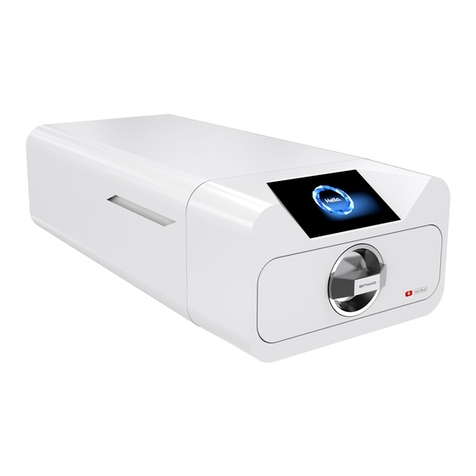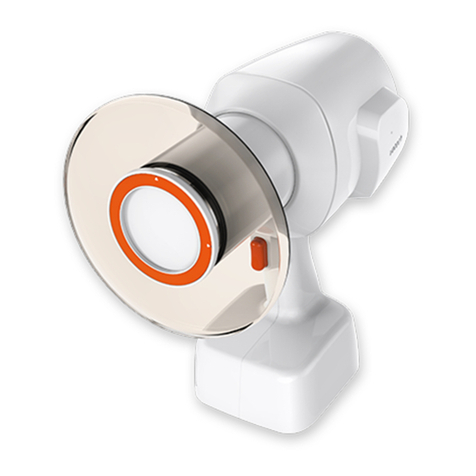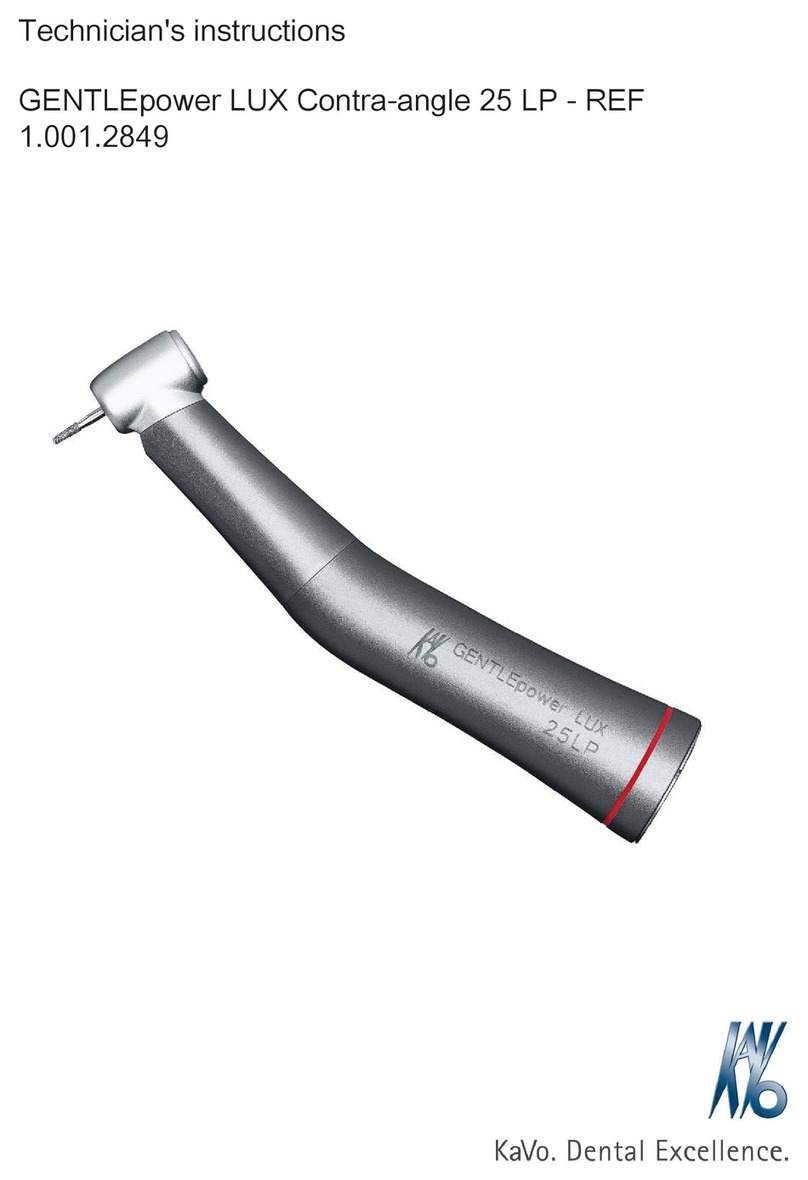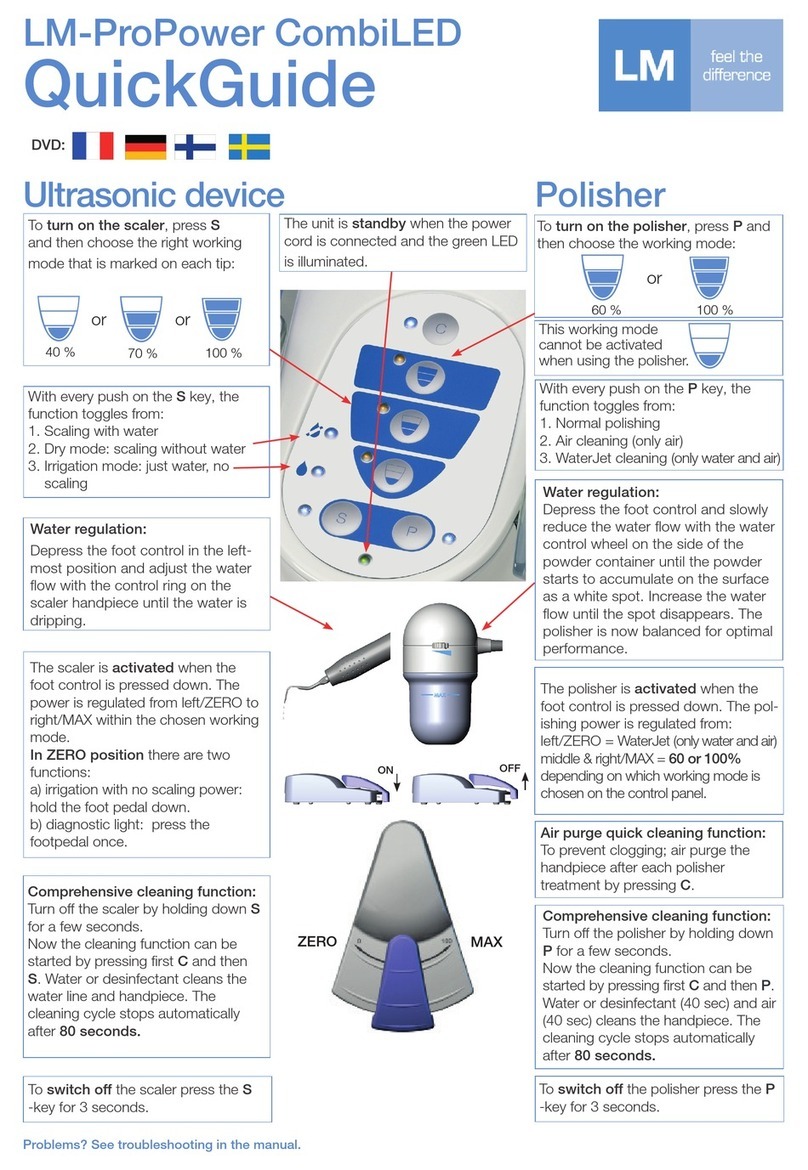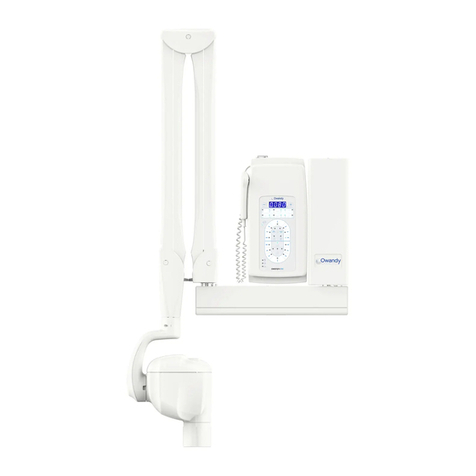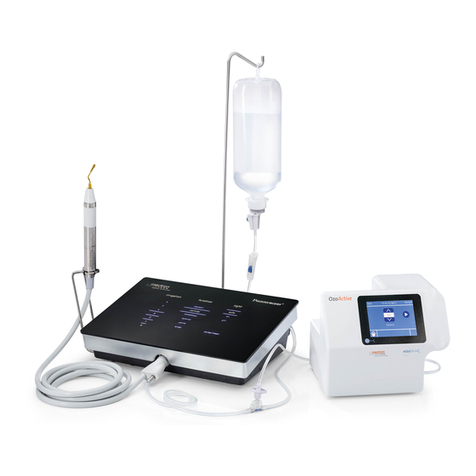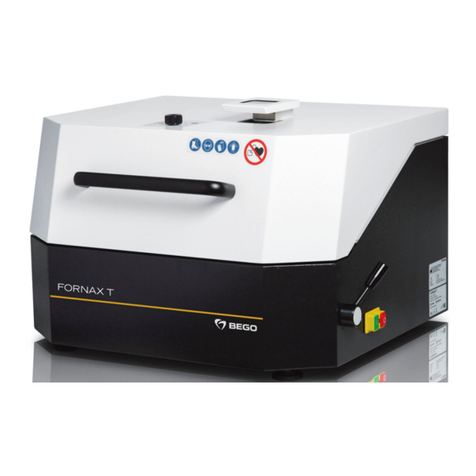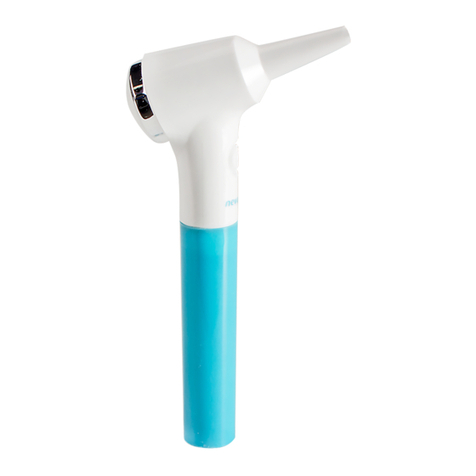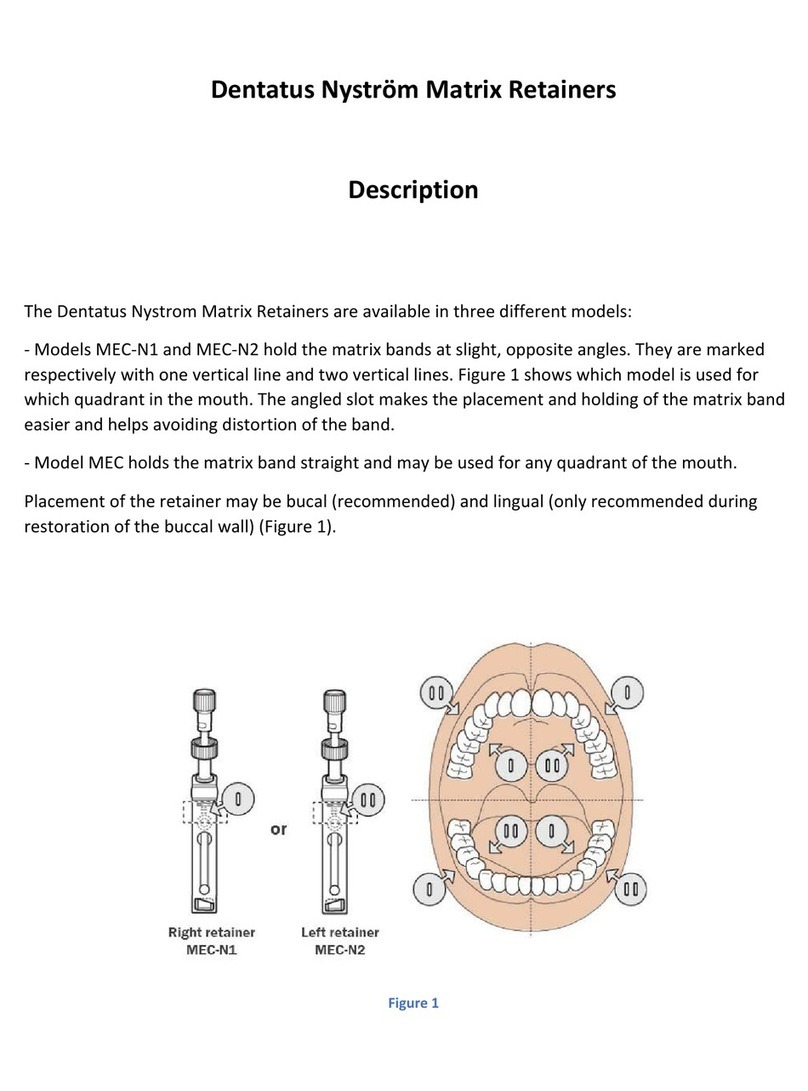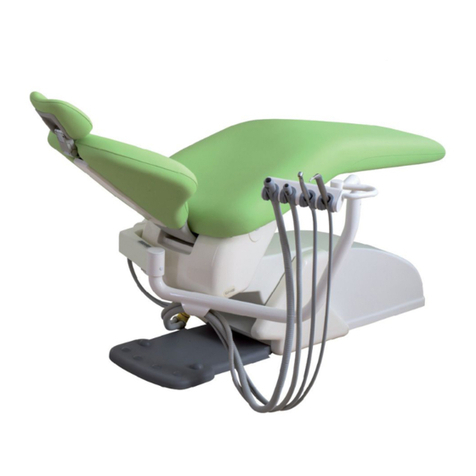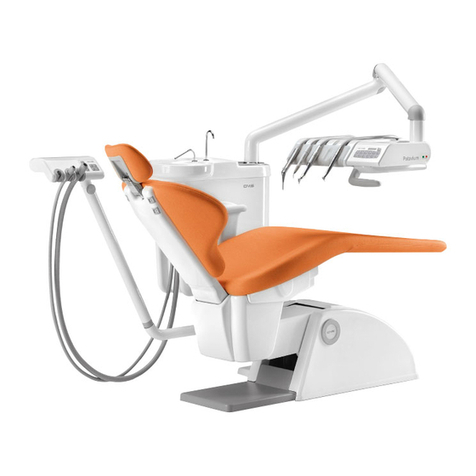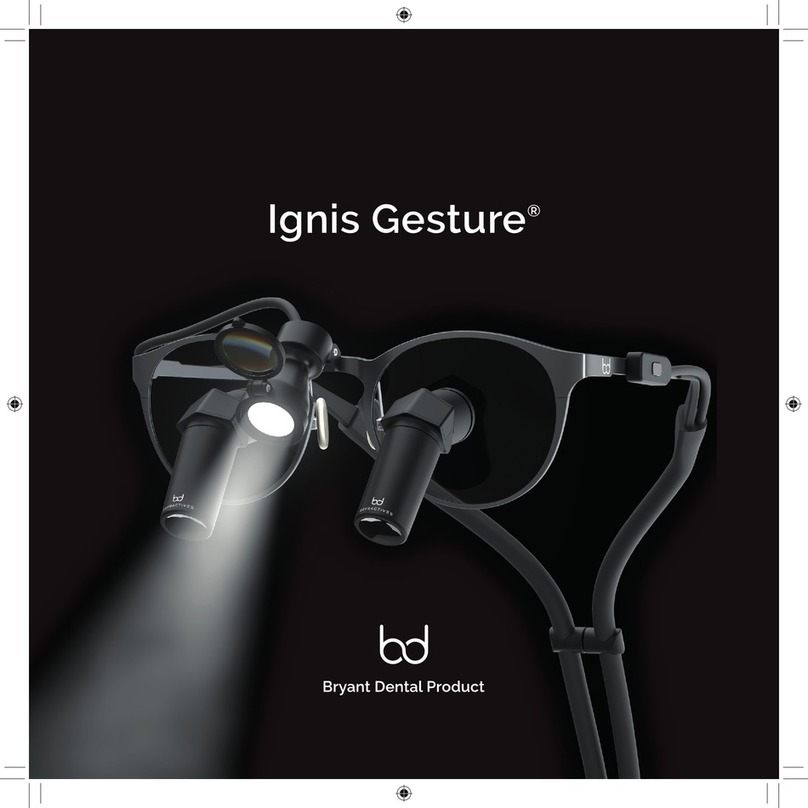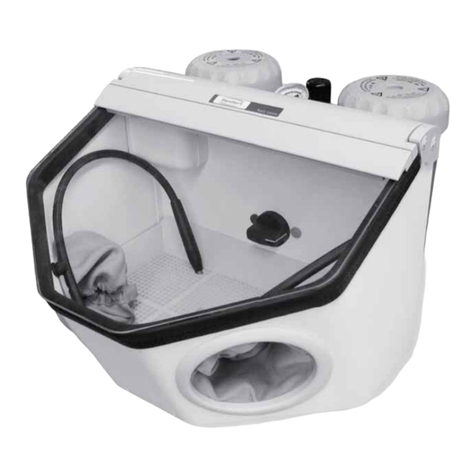Produits Dentaires MAP System Manual

Directions for use
Mode d’emploi
Gebrauchsanweisung
указания по применению


DIRECTIONS FOR USE GB
1. Indications for use............................................................................................................................................................................................................ 4
2. Contraindications............................................................................................................................................................................................................. 4
3. Warning.................................................................................................................................................................................................................................... 4
4. Precautions ............................................................................................................................................................................................................................ 4
5. Adverse reactions.............................................................................................................................................................................................................. 4
6. Operating instructions................................................................................................................................................................................................... 4
7. Disinfection, cleaning and sterilization............................................................................................................................................................... 5
For dental professional use

4 . MAP System . Directions for use
1. Indications for use
The MAP system is used in hospital environments, clinics or dental offices by qualified dental personnel. The
MAP System is designed for manually depositing any type of root canal repair material.
2. Contraindications
None known.
3. Warning
None known.
4. Precautions
4a. Sterilization of instruments before use is essential.
4b. Clean inside the head immediately before the repair material has hardened. If this is not done, it may be very
difficult, if not impossible, to unblock and clean the device.
5. Adverse reactions
None known.
6. Operating instructions
nRefer to the illustrated user guide on the last page
Preparing the instrument
1Insert the piston into the corresponding head.
Fix the selected head on the sleeve in the following way
2+3 Press the plunger so that the bayonet tip appears.
4 Fit the piston bayonet counter system and release the plunger.
5 Screw the head into the sleeve by twisting the body of the syringe.
Filling
Ensure that at least one silicone stop is attached to the corresponding head (if the repair material needs to
be applied successively, attach several silicone stops).
Place the repair material in the well.
6 Thrust the end of the head into it several times so that it is filled (the plunger must be fully released so that
the greatest possible volume is available).
7 Remove excess material by sliding the silicone stop outside the end of the head.
Inserting the material
8 Press the plunger to expel the material.
Fill the instrument again if necessary.
9 When the material has been fully inserted, press the plunger 2 or 3 times to expel as much material as
possible.
10 Unscrew the head by twisting the body of the syringe.
11 Press the plunger of the syringe and take the piston* out of the bayonet system.
* PEEK pistons are intended for single use only

MAP System . Directions for use .5
Clean the inside of the head using the cleaning curette. To clean the head thoroughly, insert the cleaning
curette with a twisting, clockwise movement. Pull it out, again with a twisting, clockwise movement.
12 Clean the parts with a cleaning and disinfecting product.
If necessary, clean the aluminum sterilization case (avoid using a dishwasher, ultrasonic bath and acid or
basic chemicals for cleaning).
Dry the parts with compressed air.
Attach one or more silicone rings to the head (refills are available in dispensers, ref 20252 yellow,
ref 20253 red, ref 20254 blue and ref 20255 green).
Place the parts in the sterilization case, without inserting the pistons in the corresponding heads.
Sterilize in the autoclave or by hot air.
7. Disinfection, cleaning and sterilization
Reprocessing procedure for dental instruments and radicular devices. Do not exceed 200°C (392°F)
Foreword
For hygiene and sanitary safety purposes, all instruments not marked «sterile» must be cleaned, disinfected and
sterilized before each usage to prevent any contamination.
A. Area of application
Disinfection and Sterilization before first usage and reprocessing procedures concerning:
1. Instruments
Root canal filling instruments (Pluggers, spreaders, compactors).
Supports, kits and instrument organizers.
B. Filling material
Please refer to the individual Direction for use.
General recommendation
Use only a disinfecting solution which is approved for its efficacy (VAH/DGHM-listing, CE marking, FDA approval)
and in accordance with the DFU of the disinfecting solution manufacturer. For all metal instruments, it is
recommended to use anticorrosion disinfecting and cleaning agents.
For your own safety, please wear personal protective equipment (gloves, glasses, mask).
The user is responsible for the sterility of the product for the first cycle and each further usage as well as for the
usage of damaged or dirty instruments where applicable after sterility.
Limitations and restrictions on reprocessing: The appearance of defects such as cracks, deformations (bent,
twisted), corrosion, loss of color coding or marking, are indications that the devices are not able to fulfill the
intended use with the required safety level.
Single use marked instruments are not approved for re-use.
The water quality has to comply with the local regulations especially for the last rinsing step or with a washer-disinfector.
Plastic supports, hand instruments and NiTi instruments are degraded by Hydrogen Peroxide (H2O2) solution.
NiTi Instruments are degraded if immerged more than 5 minutes in a solution of NaOCl at more than 5 %.
Instruments made of aluminum are degraded in presence of caustic soda solutions with mercury salt.
Do not use acid (pH < 6) or alkaline (pH > 8) solutions.
The washer-disinfector is not recommended for aluminum sterilization case.

6 . MAP System . Directions for use
C. Step By Step Procedure
A1. Instruments
Operation Operating mode Warning First use Following
uses
1 Disassembling Disassemble the device, if required Silicone stops have to be removed.
2 Pre-Disinfection Soak all instruments immediately after use in a
detergent and disinfecting solution combined
with proteolytic enzyme if possible.
Follow instructions and observe concentrations and
immersion times given by the manufacturer (an excessive
concentration may cause corrosion or other defects on
instruments).
The disinfecting solution should be aldehyde free (to avoid
blood impurities fixation) and without di- or triethanola-
mines as corrosion inhibitor.
Do not use disinfecting solutions containing Phenol or any
products which are not compatible with the instruments
(see general recommendations).
For visible impurities observed on instruments a pre-clea-
ning is recommended by brushing them manually with
soft material.
3 Rinsing Abundant rinsing (at least 1 min) Use quality water in accordance with local regulations.
If a pre-disinfectant solution contains a corrosion inhibi-
tor, it is recommended to rinse the instrument just before
the cleaning.
4a Automated cleaning with
washer-disinfector
Place the devices in a kit, box or container to
avoid any contact between instruments.
Put them in the washer-disinfector (Ao value
> 3000 or, at least 5 min at 90 °C).
Discard any instruments with large obvious defects
(broken, bent).
Avoid any contact between instruments. When placing
in the washer-disinfector use kits, supports or container.
Follow instructions and observe concentrations given
by the manufacturer (also see general recommendations).
Use only approved washer-disinfector according to EN ISO
15883, maintain and calibrate regularly.

MAP System . Directions for use .7
A1. Instruments
Operation Operating mode Warning First use Following
uses
OR
4b Manual cleaning or assisted
by an ultrasonic device
Place the devices in a kit, box or container to
avoid any contact between instruments.
Immerse in the disinfecting solution with
cleaning properties, assisted by an ultrasonic
device if suitable.
No visible impurities should be observed on the instru-
ments.
Discard any instruments with large obvious defects
(broken, bent, and twisted).
Follow instructions and observe concentrations and time
given by the manufacturer (see general recommendations
under section 7).
The disinfecting solution should be aldehyde free and wit-
hout di- or triethanolamines as corrosion inhibitor.
5 Rinsing Abundant rinsing (at least 1 min) Use quality water in accordance with local regulations.
If a disinfecting solution contains a corrosion inhibitor,
it is recommended to rinse the instruments just before
the autoclaving.
Dry on a single use non-woven cloth, or with a drying
machine or filtered compressed air.
6 Inspection Inspect devices and sort out those with
defects.
Assemble the devices (stops)
Dirty instruments must be cleaned and disinfected again.
Discard instruments which show any deformations (bent,
twisted), damages (broken, corroded) or defects (loss of
color coding or marking) affecting the resistance, the
safety or the performance of the instrument.
7 Packaging Place the devices in a kit, box or container to
avoid any contact between instruments and
pack the devices in “Sterilization pouches”.
Check the validity period of the pouch given by the
manufacturer to determine the shelf life.
Use packaging which are resistant up to a temperature of
141°C (286°F) and in accordance with EN ISO 11607.
8 Sterilization Steam sterilization at : 134 °C / 273°F during
18 min. at 2, 1 bar.
Check the success of the sterilisable cycle
(use physico-chemical indicator for each
performed cycle.)
The instruments, posts and the plastic supports must be
sterilized according to the packaging labelling.
Use only autoclaves that are matching the requirements
of EN 13060, EN 285.
The sterilization protocol has been validated by Produits
Dentaires SA according to EN ISO 17665.
Use only this recommended sterilization procedure.
Control the efficiency (packaging integrity, no humidity,
color change of sterilization indicators, physico-chemical
integrators, digital records of cycles parameters).
Traceability of procedure records.
9 Storage Keep devices in sterilization packaging in a
dry and clean environment
Sterility cannot be guaranteed if packaging is open,
damaged or wet.
Check the packaging and the medical devices before
using them (packaging integrity, no humidity and
validity period).

page blanche 08

MAP System . Directions for use .9
mODE D’EmplOI F
1. Indications d’utilisation............................................................................................................................................................................................... 10
2. Contre indications.......................................................................................................................................................................................................... 10
3. Mise en garde.....................................................................................................................................................................................................................10
4. Précautions ..........................................................................................................................................................................................................................10
5. Effets secondaires............................................................................................................................................................................................................10
6. Instructions d’utilisation..............................................................................................................................................................................................10
7. Désinfection, nettoyage et stérilisation ...........................................................................................................................................................11
Pour usage professionnel dentaire

10 . MAP System . Directions for use
1. Indications d’utilisation
Le MAP system ne doit être utilisé que dans les hôpitaux, les cliniques ou cabinets dentaires disposant d’un
personnel qualifié en dentisterie. Le MAP system est conçu pour déposer manuellement tout type de matériau
de réparation des canaux radiculaires.
2. Contre indications
Aucune connue.
3. Mise en garde
Aucune connue.
4. Précautions
4a) Il est indispensable de procéder à la stérilisation des instruments avant utilisation.
4b) Nettoyer immédiatement l’intérieur de la tête avant que le matériel de réparation n’ait durci. A défaut, il pourrait
s’avérer que le débouchage/nettoyage ne devienne très difficile, sinon impossible.
5. Eets secondaires
Aucun connu.
6. Instruction d’utilisation
nSe reporter à la procédure illustrée en dernière page.
Préparation de l’instrument:
1Introduire avec précaution le piston dans la tête correspondante.
Fixer la tête choisie sur le manche de la manière suivante:
2+3 Presser le poussoir de manière à faire apparaître l’embout « baïonnette ».
4Y adapter le contre-système baïonnette du piston. Relâcher le poussoir.
5Visser la tête dans la manche en tournant le corps de la seringue.
Remplissage
S’assurer qu’au moins un stop de silicone est enfilé sur la tête correspondante (si plusieurs mises en place
successives de matériel de réparation sont prévues, enfiler plusieurs stops de silicone).
Mettre le matériel de réparation dans le puits.
6Y plonger plusieurs fois l’extrémité de la tête pour la remplir (le poussoir doit être complètement relâché
de manière à avoir le plus grand volume possible disponible).
7Enlever l’excès de matériel en glissant le stop de silicone hors de l’extrémité de la tête.
Mise en place du matériel
8Presser le poussoir pour expulser le matériel. Remplir à nouveau l’instrument si nécessaire.
9A la fin de la mise en place complète du matériel, presser 2 à 3 fois le poussoir pour expulser le plus possible
de matériel.
10 Dévisser la tête en tournant le corps de la seringue.
11 Enfoncer le poussoir de la seringue et retirer le piston* du système baïonnette.
* Les pistons PEEK sont à usage unique

MAP System . Directions for use .11
Nettoyer l’intérieur de la tête à l’aide de la curette de nettoyage. Pour que la tête soit parfaitement propre,
insérer la curette de nettoyage en la tournant dans le sens des aiguilles d’une montre, puis la retirer de la
même façon.
12 Nettoyer les pièces à l’aide d’un produit de nettoyage désinfectant.
Si nécessaire, nettoyer le conteneur de stérilisation en aluminium (éviter d’utiliser un auto-laveur/
désinfecteur, un bac à ultrasons ou des produits chimiques acides ou basiques pour le nettoyage).
Sécher les pièces à l’air comprimé.
Enfiler un ou plusieurs anneaux de silicone sur la tête (les recharges sont disponibles en dispenser, ref 20252
jaune, ref 20253 rouge, ref 20254 bleu et ref 20255 vert).
Ranger les pièces dans le coffret de stérilisation sans introduire les pistons dans les têtes correspondantes.
Stériliser à l’autoclave ou à l’air chaud.
7. Désinfection, nettoyage et stérilisation
Protocole de stérilisation pour l’instrumentation dentaire et les systèmes radiculaires. Ne pas dépasser 200°C
(392°F)
Préambule
Pour des raisons d’hygiène et desécurité sanitaire: afin d‘éviter lesrisques de contamination, toujours biennettoyer,
désinfecter et stériliser – avant 1ère utilisation et avant chaque réutilisation – les instruments non marqués stérile.
A. Domaine d’application
La désinfection et la stérilisation avant 1ère utilisation, ainsi que les protocoles de stérilisation concernant:
1. Instruments
Instruments d’obturation (fouloirs, évaseurs, compacteurs).
Supports, kits et systèmes de rangement des instruments.
2. Matériaux d’obturation
Se reporter au mode d’emploi correspondant.
B. Recommandations générales
Utiliser uniquement une solution désinfectante dont l’efficacité a été approuvée (liste VAH/DGHM, marquage CE,
agrément FDA) et l’utiliser en suivant les instructions d’utilisation figurant dans son mode d’emploi.
Pour les instruments métalliques, il est recommandé d’utiliser une solution nettoyante et désinfectante qui
contienne un agent anticorrosif.
Pour votre propre sécurité, veuillez porter les équipements de protection individuelle requis (gants, masque et
protection oculaire).
La stérilisation du produit avant première utilisation et réutilisation est de la responsabilité de l’utilisateur. De
même, pour le cas où ce dernier utiliserait des instruments sales et/ou abîmés, il en assumera là aussi l’entière
responsabilité, si applicable après avoir été stérilisé.
Limites et restrictions concernant la stérilisation
La présence de défauts tels que fissures, déformations (instrument plié ou tordu), corrosion, ou disparition du
codage couleur ou du marquage, sont le signe que l‘instrument n‘est plus en mesure d‘assumer avec le niveau
de fiabilité requis la fonction pour laquelle il a été conçu.
La réutilisation des instruments marqués à usage unique n‘est pas autorisée.

12 . MAP System . Directions for use
La qualité de l‘eau devra être conforme à la règlementation locale en vigueur et ce, tout particulièrement
concernant l‘eau du dernier rinçage/l‘eau du désinfecteur
Le peroxyde d’hydrogène (H2O2) dégrade les supports en plastique, les instruments à main et les instruments NiTi.
Ne pas laisser les instruments NiTi plus de 5 minutes dans une solution de NaOCl à plus de 5 %.
Les solutions à base de soude caustique ou de sel de mercure dégradent les instruments en aluminium. Ne pas
non plus utiliser de solutions acides (pH < 6) ou alcalines (pH > 8).
Il est déconseillé de nettoyer la boîte en aluminium de stérilisation à l’auto-laveur/désinfecteur.
C. Procédure étape par étape
A1. Instrumentation
Etape Mode opératoire Mise en garde
1ère
utilisa-
tion
Utilisa-
tions
suivantes
1 Démontage Démonter les systèmes si nécessaire. Bien retirer les stops silicone.
2 Prédésinfection Après utilisation, plonger aussitôt tous les instru-
ments dans une solution détergente et désinfectante,
en y associant si possible un enzyme protéolytique.
Bien respecter les concentrations et les temps de
trempage indiqués par le fabricant car une concentration
trop élevée par exemple peut provoquer, entre autres, la
corrosion des instruments.
La solution désinfectante devra être sans aldéhyde afin
d’éviter la fixation de résidus sanguins. Elle ne devra pas
non plus contenir d’agent anticorrosion de type di ou
triétahanolamines.
Ne pas utiliser de solution désinfectante à base de phénol
ou contenant des substances non compatibles avec les
instruments (voir recommandations générales).
Si vous voyez des salissures sur l’instrument, commencez
par le nettoyer avec une lingette.
3 Rinçage Rincer abondamment (pendant au moins 1 minute). La qualité de l’eau devra être conforme à la règlementa-
tion locale en vigueur.
Si la solution de prédésinfection utilisée contient un
agent anticorrosion, il est recommandé de bien rincer les
instruments juste avant de les nettoyer..
4a Nettoyage
automatique avec le
désinfecteur-laveur
Placer les instruments dans un kit, un conteneur
ou sur un support adéquat afin qu’il n’y ait pas de
contact entre les instruments.
Les introduire ensuite dans le désinfecteur-laveur
et les y laisser pendant au moins 5 min. à 90°C (ou
Ao > 3000).
Débarrassez-vous des instruments présentant des défauts
(instruments cassés ou pliés par exemple).
Placez les instruments à l’intérieur du désinfecteur-laveur
en faisant en sorte qu’ils ne se touchent pas. Pour ce faire,
utiliser les kits, supports ou conteneurs correspondants.
Bien suivre les instructions, bien respecter les
concentrations indiquées par le fabricant (voir aussi :
Recommandations générales)
Le désinfecteur-laveur devra obligatoirement être
conforme à la norme EN ISO 15883 et faire l’objet d’un
entretien et d’un étalonnage réguliers.

MAP System . Directions for use .13
A1. Instrumentation
Etape Mode opératoire Mise en garde
1ère
utilisa-
tion
Utilisa-
tions
suivantes
OU
4b Nettoyage manuel
avec ou sans recours
aux ultrasons
Placer les instruments dans un kit, un conteneur
ou sur un support adéquat afin qu’il n’y ait pas de
contact entre les instruments.
Les plonger dans une solution désinfectante ayant
des propriétés nettoyantes et, si nécessaire, utiliser
les ultrasons.
Vous ne devriez plus voir aucune salissure sur les
instruments.
Débarrassez-vous des instruments présentant des défauts
(instruments cassés, plies ou tordus par exemple).
Bien suivre les instructions, bien respecter les
concentrations indiquées par le fabricant (voir aussi :
Recommandations générales).
La solution désinfectante devra être sans aldhéyde et
sans agent anticorrosion de type di ou triéthanolamines.
5 Rinçage Rincer abondamment (pendant au moins 1 minute). La qualité de l’eau devra être conforme à la règlementa-
tion locale en vigueur.
Si la solution de prédésinfection utilisée contient un
agent anticorrosion, il est recommandé de bien rincer les
instruments juste avant l’autoclavage.
Pour le séchage, utiliser une serviette en non-tissé, la
machine de séchage ou l’air comprimé (air préfiltré!).
6 Inspection Contrôler l’état des instruments et se débarrasser de
ceux qui présentent des défauts.
Réassembler les instruments (monter les stops)
Si des instruments sont encore sales, les renettoyer.
Débarrassez-vous des instruments présentant des défor-
mations (instruments pliés ou tordus) ou abîmés (cassés,
attaqués par la corrosion) ou présentant d’autres défauts
(comme par exemple la disparition du code couleur, du
marquage) pouvant avoir des conséquences sur la résis-
tance, la fiabilité et/ou les performances du produit.
7 Emballage Placer les systèmes dans un kit, un conteneur ou sur
un support adéquat afin qu‘il n‘y ait pas de contact
entre les instruments, et les emballer dans des
sachets de stérilisation.
Bien regarder la date limite de validité du sachet indiquée
par le fabricant.
Utiliser un emballage pouvant supporter des
températures jusqu’à 141°C (286°F) et qui soit conforme
à EN ISO 11607.
8 Stérilisation Stérilisation à la vapeur à 134°C (273°F) pendant 18
min. Stérilisation à 2, 1 bar.
Vérifier le bon déroulement du cycle de stérilisation.
Utiliser un indicateur physicochimique pour chaque
cyle de stérilisation
Stériliser les instruments et les supports en plastique en
suivant bien les instructions qui figurent sur l’emballage.
Utiliser seulement un autoclave qui devra être conforme
aux normes EN 13060 et EN 285.
Effectuer l’entretien et la maintenance de l’autoclave en
suivant bien les instructions du fabricant.
Ne pas utiliser d’autres protocoles de stérilisation que
celui indiqué.
Vérifier que l‘efficacité obtenue est correcte (intégrité
de l‘emballage, absence d‘humidité, changement de
couleur des indicateurs de stérlisation, intégrateurs
physico-chimiques, enregistrements numériques des
paramètres des différents cycles).
Garantir la traçabilité des protocoles enregistrés.
9 Stockage Placer les sachets de stérilisation (avec les instru-
ments à l’intérieur) dans un endroit sec et propre.
Si l’emballage a été ouvert, endommagé ou mouillé,
l’état stérile des instruments se trouvant à l’intérieur
n’est pas garanti.
Contrôler l‘état de l‘emballage et des dispositifs médicaux
avant d‘utiliser ces derniers (intégrité de l‘emballage,
absence d‘humidité et date limite de validité).

page blanche 16

MAP System . Directions for use .15
GEBRAUCHSANWEISUNG D
1. Indikationen ....................................................................................................................................................................................................................... 16
2. Kontraindikationen........................................................................................................................................................................................................ 16
3. Warnhinweise.....................................................................................................................................................................................................................16
4. Vorsichtsmassnahmen.................................................................................................................................................................................................16
5. Unerwünschte wirkungen.........................................................................................................................................................................................16
6. Bedienungsanleitung...................................................................................................................................................................................................16
7. Desinfektion, reinigung und sterilisation........................................................................................................................................................17
Für den professionellen zahnärztlichen Gebrauch.

16 . MAP System . Directions for use
1. Indikationen
Das MAP system darf nur in Universitätskliniken und Zahnartzpraxen von qualifizierten Personen verwendet
werden. Das MAP system dient zur manuellen Applikation von MTA Wurzelkanal-Reparaturmaterial .
2. Kontraindikationen
Keine bekannt.
3. Warnhinweise
Keine bekannt.
4. Vorsichtsmassnahmen
4a) Die Instrumente müssen vor der Verwendung sterilisiert werden.
4b) Das Innere der Kanüle unverzüglich reinigen, bevor das Reparaturmaterial aushärtet. Anderenfalls wird die
Beseitigung des MTA und die Reinigung des Instruments eventuell sehr schwierig bzw. unmöglich.
5. Unerwünschte wirkungen
Keine bekannt.
6. Bedienungsanleitung
nNehmen Sie Bezug auf die letzte Seite im illustrierten Handbuch.
Vorbereitung des Instruments
1Den Kolben in die zugehörige Kanüle einsetzen.
Die gewählte Kanüle folgendermaßen an der Spritze befestigen:
2+3 Auf den Stempel drücken, so dass die « Bajonett »-Spitze erscheint.
4Das Kolben-Bajonett-System zusammensetzen und den Stempel loslassen.
5Den Kopf durch Drehen des Spritzenkörpers in den Zylinder schrauben.
Befüllen
Sicherstellen,dass mindestenseinSilikonstopperambetreffendenKopf ange-bracht ist(fallsdasReparaturmaterial
sukzessive appliziert werden muss, werden mehrere Silikonstopper angebracht).
Das Reparaturmaterial in das vorgesehene Gefäß geben.
6Das Kopfende mehrmals hineindrücken, so dass es befüllt wird (der Stempel muss dabei völlig locker
gelassen werden, so dass die größtmögliche Materialmenge zur Verfügung steht).
7Entfernung von Materialüberschüssen durch Entlangschieben des Silikonstoppers an der Außenseite des
Kopfendes.
Applikation des Materials
8Das Material durch Druck auf den Stempel ausbringen.
Das Instrument nachfüllen, falls erforderlich.
9NachAbschluss derApplikation den Stempel2-bis 3-mal ganzdurchdrücken, um soviele Materialrückstände
wie möglich aus dem Kopf zu entfernen.
10 Den Kopf durch Drehen des Spritzenkörpers abschrauben.
11 Auf den Spritzenstempel drücken und den Kolben* aus dem Bajonett-System nehmen.
* PEEK-Kolben sind nur für den Einmalgebrach bestimmt

MAP System . Directions for use .17
Das Innere der Kanüle mit Hilfe der Reinigungskürette säubern. Für eine gründliche Reinigung die Kürette
beim Einschieben in die Kanüle im Uhrzeigersinn drehen. Beim Herausziehen ebenfalls im Uhrzeigersinn
drehen.
12 Die Teile mit einem Reinigungs- und Desinfektionsmittel reinigen.
Falls erforderlich, die Aluminium-Sterilisationskassette reinigen (bitte nicht in der Spülmaschine, im
Ultraschallbad oder mit sauren oder basischen Chemikalien).
Die Teile mit Druckluft trocknen.
Eine oder mehrere Silikonringe am Kopf anbringen (Nachfüllpackungen in Form von Spendern erhältlich
unter ref 20252 gelb, ref 20253 rot, ref 20254 blau und ref 20255 grün).
Die Teile in die Sterilisationskassette geben, wobei die Kolben nicht in die zugehörigen Köpfe eingesetzt
sein dürfen.
Im Autoklav oder mit Heißluft sterilisieren.
7. Desinfektion, Reinigung und Sterilisation
Aufbereitung zahnärztlicher Instrumente und Wurzelsysteme.
200°C (392°F) darf nicht überschritten werden.
Vorbemerkung
AusGründen derHygieneund der sanitärenSicherheitmüssen alle nicht als «steril»gekennzeichneten Instrumente
vor jeder Verwendung gereinigt, desinfiziert und sterilisiert werden, um Kontaminationen zu vermeiden.
A. Anwendungsbereich
Desinfektion und Sterilisation vor der ersten Verwendung sowie weitere Aufbereitung der folgenden Produkte:
1. Instrumente
Instrumente zur Wurzelkanalfüllung (Plugger, Spreader, Kompaktoren). Ständer, Kits und Organisationssysteme
für Instrumente.
B. Füllungsmaterialien
Bitte die entsprechende Gebrauchsanweisung beachten.
Allgemeine Hinweise und Empfehlungen
Nur eine Desinfektionslösung verwenden, deren Wirksamkeit offiziell geprüft wurde (VAH/DGHM- Listung,
CEKennzeichnung, FDA-Zulassung), und die Gebrauchsanweisung des Lösungsherstellers beachten. Für
metallische Instrumente wird empfohlen, eine Reinigungs- und Desinfektionslösung zu benützen die ein
Korrosionsschutz enthält.
Zur Ihrer eigenen Sicherheit bitte persönliche Schutzausrüstung tragen (Schutzhandschuhe, -brille, -maske).
Für die Sterilität der einzelnen Produkte, sowohl beim ersten als auch bei jedem weiteren Gebrauch, sowie für
eine eventuelle Verwendung beschädigter oder verunreinigter Instrumente gegebenenfalls nach der Sterilisation
trägt der Anwender die Verantwortung
Einschränkungen der Aufbereitbarkeit
Das Auftreten von Defekten, wie z.B. Rissen, Verformungen (verbogen, verzogen), Korrosion oder Verlust von
Farbcodierungen bzw. Markierungen, lässt darauf schließen, dass das Produkt bei der vorgesehenen Verwendung
die Sicherheitsanforderungen nicht mehr erfüllt.
Als Einmal-Artikel gekennzeichnete Instrumente sind nicht zur Wiederverwendung geeignet.
Die Wasserqualität muss den örtlichen Vorschriften entsprechen, insbesondere beim abschließenden Spülen

18 . MAP System . Directions for use
bzw. bei Gebrauch eines Reinigungs- und Desinfektionsgeräts.
Wasserstoffperoxid-Lösung (H2O2), NiTi- und Handinstrumente sowie Kunststoffständer an.
NiTi-Instrumente werden angegriffen, wenn man sie länger als 5 Minuten in über 5 %iger NaOCl-Lösung einweicht.
AluminiuminstrumentewerdenvonNatriumhydroxid-Lösungen mit Quecksilbersalzenangegriffen.Keinesauren
(pH < 6) oder alkalischen (pH > 8) Lösungen verwenden.
Die Aluminium-Sterilisationskassette sollte nicht in einem Reinigungs- und Desinfektionsgerät behandelt werden
C. Vorgehensweise Schritt für Schritt
A1. Instrumentation
Vorgang Verfahren Warnhinweise Erste
Verwendung
Weitere
Verwendungen
1 Auseinander
nehmen
Die Produkte, falls nötig, auseinander
nehmen.
Silikonstopper müssen entfernt werden.
2 Vordesinfektion Alle Instrumente unmittelbar nach Gebrauch
in einer Reinigungs- und Desinfektionslösung,
wenn möglich mit proteolytischem Enzym,
einweichen.
Anleitung des Herstellers sowie Angaben zu Konzentra-
tionen und Einwirkzeiten beachten (zu hohe Konzentra-
tionen können bei den Instrumenten zu Korrosion oder
anderen Defekten führen).
Die Desinfektionslösung sollte aldehydfrei sein (um
eine Fixierung von Blutverunreinigungen zu vermeiden)
und kein Di- oder Triethanolamin als Korrosionsinhibitor
enthalten.
Keine Desinfektionslösungen verwenden, die Phenol
oder sonstige mit den Instrumenten inkompatible
Substanzen enthalten (siehe Allgemeine Hinweise und
Empfehlungen).
Wenn an den Instrumenten sichtbare Verunreinigungen
anhaften, sollten diese noch vor der Desinfektion mit einer
weichen Bürste von Hand entfernt werden.
3 Spülen Gründlich spülen (mindestens 1min). Die Wasserqualität muss den örtlichen Vorschriften
entsprechen.
Wenn die Vordesinfektionslösung einen Korrosionsinhi-
bitor enthält, ist es ratsam, die Instrumente direkt vor der
Reinigung zu spülen.
4a Automatische
Reinigung
mittels Reini-
gungs- und
Desinfek-
tionsgerät
Instrumente in Kit Ständer oder Behälter
geben, damit sie nicht miteinander in Kontakt
kommen.
Im Reinigungs- und Desinfektionsgerät
behandeln (Ao-Wert > 3000 oder mindestens
5min bei 90°C).
Instrumente mit größeren, deutlich sichtbaren Defekten
(gebrochen, verbogen) entsorgen.
Jeden Kontakt zwischen den Instrumenten während
der Behandlung im Reinigungs- und Desinfektionsgerät
vermeiden. Kits, Ständer oder Behälter verwenden.
Anleitung und Konzentrationsangaben des Herstellers
beachten (siehe auch Allgemeine Hinweise und
Empfehlungen).
Ausschließlich ein nach EN ISO15883 geprüftes Reini-
gungs- und Desinfektionsgerät verwenden und dieses
regelmäßig warten und kalibrieren.

MAP System . Directions for use .19
A1. Instrumentation
Vorgang Verfahren Warnhinweise Erste
Verwendung
Weitere
Verwendungen
ODER
4b Rein manuelle
Reinigung, evtl.
Ultraschallbad
Instrumente in Kit, Ständer oder Behälter
geben, damit sie nicht miteinander in Kontakt
kommen.
In Desinfektionslösung mit Reini-
gungs-wirkung einlegen, falls möglich im
Ultraschabad.
Die Instrumente sollten keine sichtbaren Verunreini-
gungen zeigen.
Instrumente mit größeren, deutlich sichtbaren Defekten
(gebrochen, verbogen, verzogen) entsorgen.
Anleitung sowie Konzentrations- und Zeitangaben des
Herstellers beachten (siehe auch Allgemeine Hinweise
und Empfehlungen).
Die Desinfektionslösung sollte aldehydfrei sein und kein
Di- oder Triethanolamin als Korrosionsinhibitor enthalten.
5 Spülen Gründlich spülen (mindestens 1 min). Die Wasserqualität muss den örtlichen Vorschriften
entsprechen.
Wenn die Desinfektionslösung einen Korrosionsinhibitor
enthält, ist es ratsam, die Instrumente direkt vor dem
Auf einem Einmal-Vliestuch, in einem Trockengerät oder
mit gefilterter Druckluft trocknen..
6 Kontrolle Produkte kontrollieren und alle fehlerhaften
aussortieren.
Produkte wieder zusammensetzen (Stopper).
Noch verschmutzte Instrumente müssen erneut gereinigt
und desinfiziert werden.
Instrumente bzw. Stifte mit Verformungen (verbogen,
verzogen), Schäden (gebrochen, korrodiert) oder sonstigen
Fehlern (Verlust der Farbcodierung oder Kennzeichnung),
die ihre Widerstandsfähigkeit, Sicherheit oder Leistung
beeinträchtigen können, entsorgen.
7 Verpackung Instrumente in Kit, Ständer oder Behälter
geben, damit sie nicht miteinander in
Kontakt kommen, und in Sterilisationshüllen
verpacken.
Jeden Kontakt zwischen den Instrumenten während
der Sterilisation vermeiden. Kits, Ständer oder Behälter
verwenden.
Das vom Hersteller angegebene Haltbarkeitsdatum der
Hüllen kontrollieren, um sicherzugehen, dass sie noch
verwendbar sind..
Die verwendeten Hüllen sollten Temperaturen von bis zu
141°C standhalten und EN ISO 11607 entsprechen..
8 Sterilisation Dampfsterilisation bei 134°C / 273°F für 18
min bei 2,1 bar
Prüfen Sie, ob der Sterilisationszyklus erfol-
greich durchgeführt wurde Verwenden Sie die
physikochemische Anzeige für jeden Zyklus.
Instrumente und Kunststoffständer müssen gemäß den
Angaben auf dem Verpackungsetikett sterilisiert werden.
Autoklaven mit fraktioniertem Vorvakuum- (bevorzugt)
oder mit Gravitations-Verfahren benutzen (gemäß EN
13060, EN 285).
Das Sterilisationsprotokoll wurde von Produits Dentaires
SA nach EN ISO 17665 validiert.
Angaben des Herstellers zur Wartung des Autoklavs
beachten.
Ausschließlich das empfohlene Sterilisationsverfahren
anwenden.
Wirksamkeit kontrollieren (intakte Verpackung, keine
Feuchtigkeit, Farbumschlag von Sterilisationsindikatoren,
physikalisch-chemische Integratoren, digitale Aufzeich-
nung der Zyklus-Parameter).
Verfolgbarkeit des Verfahrensablaufs.
9 Lagerung Die Produkte in ihren Sterilisationshüllen in
einer trockenen und sauberen Umgebung
aufbewahren.
Bei offener, beschädigter oder feuchter Verpackung ist
die Sterilität der Produkte nicht gewährleistet.
Verpackung und Produkte vor Gebrauch kontrollieren
(intakte Hülle, keine Feuchtigkeit, Haltbarkeitsdatum nicht
überschritten).

page blanche 20
Table of contents
Languages:

